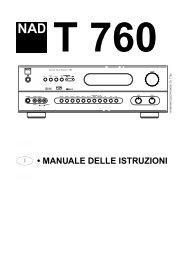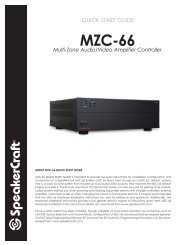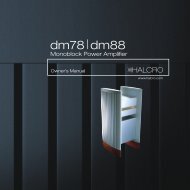Palladium® - Hi-Fi Di Prinzio
Palladium® - Hi-Fi Di Prinzio
Palladium® - Hi-Fi Di Prinzio
Create successful ePaper yourself
Turn your PDF publications into a flip-book with our unique Google optimized e-Paper software.
Palladium®<br />
Owner’s Manual<br />
P-38F<br />
P-37F<br />
P-17B<br />
P-27C<br />
P-27S
Important Safety Instructions<br />
Introduction<br />
1. READ these instructions.<br />
2. KEEP these instructions.<br />
3. HEED all warnings.<br />
4. FOLLOW all instructions.<br />
5. DO NOT use this apparatus near water.<br />
6. CLEAN ONLY with dry cloth.<br />
7. DO NOT block any ventilation openings. Install in<br />
accordance with the manufacturer’s instructions.<br />
8. DO NOT install near any heat sources such as radiators,<br />
heat registers, stoves, or other apparatus<br />
(including amplifiers) that produce heat.<br />
9. ONLY USE attachments/accessories specified by<br />
the manufacturer.<br />
10. USE only with a cart, stand, tripod, bracket, or<br />
table specified by the manufacturer, or<br />
sold with the apparatus. When a cart<br />
is used, use caution when moving the<br />
cart/apparatus combination to avoid<br />
injury from tip-over.<br />
11. UNPLUG this apparatus during lightning storms<br />
or when unused for long periods of time.<br />
12. REFER all servicing to qualified service personnel.<br />
Servicing is required when the apparatus<br />
has been damaged in any way, such as powersupply<br />
cord or plug is damaged, liquid has been<br />
spilled or objects have fallen into the apparatus,<br />
the apparatus has been exposed to rain or<br />
moisture, does not operate normally, or has<br />
been dropped.<br />
This symbol indicates that there are<br />
important operating and maintenance<br />
instructions in the literature accompanying<br />
this unit.<br />
This symbol indicates that dangerous<br />
voltage constituting a risk of electric<br />
shock is present within this unit.<br />
WARNING: To reduce the risk of fire or<br />
electrical shock, do not expose this apparatus<br />
to rain or moisture.<br />
WARNING: Voltages in this equipment are hazardous<br />
to life.<br />
No user-serviceable parts inside. Refer all servicing to<br />
qualified service personnel.<br />
CAUTION: Changes or modifications not expressly<br />
approved by the manufacturer could void the user’s<br />
authority to operate.<br />
CAUTION!<br />
Risk of electric shock<br />
do not open<br />
For over 60 years, our engineers have sought the ultimate: a loudspeaker that could reproduce recorded music<br />
with all the passion of a live performance. The Palladium Series approaches aural perfection, while making a<br />
visual statement that is every bit as elegant and passionate as the sound.<br />
The Palladium Series represents the epitome of loudspeaker technology, with remarkable clarity throughout<br />
the dynamic range and bold styling. Today, Klipsch Group, Inc. is a global force, and this loudspeaker range<br />
reflects that leadership status; design and engineering teams from the United States collaborated with colleagues<br />
from Germany and China to plan and execute the Palladium project.<br />
In designing the Palladium cabinetry, we first considered the Klipsch heritage and unique approach to acoustic<br />
design. Trends in home interior and furniture were also factored in, as was the current audio market landscape.<br />
The result is a speaker range that flawlessly melds classic Klipsch® audio with<br />
the latest in home furniture trends. The striking design hints at the power<br />
and performance inside, while maintaining a high degree of sophistication<br />
and beauty. More importantly, the arched shape of the loudspeaker actually<br />
contributes to its remarkable sound by breaking up standing waves at<br />
higher frequencies.<br />
Power. Detail. Emotion. Combined, these qualities are the embodiment of<br />
our core philosophy. And all are expressed—beautifully—in the brilliant<br />
Palladium loudspeakers. We invite you, our customer, to share with us the<br />
pride of ownership in this extraordinary product for many gratifying years.<br />
General Cautions<br />
• When making or changing any connections to<br />
your system, switch all the electronics OFF.<br />
• Do NOT listen to music for long periods at<br />
extreme volume settings. Doing so can permanently<br />
damage your hearing.<br />
• When running loudspeaker cables, do not trail<br />
them over open floor spaces where they could<br />
cause an accident. Cover them or route them<br />
around potential troublespots.<br />
• Before switching on your sound system, turn<br />
the volume level down. After switching the<br />
system on, turn the level up gradually.<br />
• Do not use extreme settings of Treble, Bass or<br />
EQ. Ideally set the tone controls “flat” and turn<br />
any EQ off.<br />
• These loudspeakers are extremely heavy. Do not<br />
move them by yourself. Always get help.<br />
If you are using the floor spikes:<br />
• Spikes are sharp! Exercise extreme caution when<br />
using spikes.<br />
• Do not drag the loudspeaker. Lift the speakers<br />
off the floor and set them down carefully when<br />
changing their location.<br />
• Be especially careful not to place a spiked<br />
loudspeaker in areas where there may be hidden<br />
obstacles that could get damaged.<br />
• Some floor surfaces can be damaged by spikes.<br />
If you are unsure, consult your flooring contractor<br />
for advice before using spikes, or use the<br />
spike seats.<br />
Page 2 Page 3
Getting Started<br />
Preparing the Loudspeaker<br />
Unpacking (P-38F / P-37F)<br />
Please follow the unpacking instructions fully and in the order shown below. These loudspeakers are<br />
heavy! Do not lift or move these speakers by yourself. Always have someone help you.<br />
1<br />
Open the carton flaps<br />
Lightly tape each flap to the box<br />
with short pieces of tape<br />
Remove the top packing piece<br />
2<br />
Remove the Grille box<br />
Remove the Accessories box<br />
Remove the Owner’s manual<br />
and gloves<br />
Connection Procedure:<br />
There is a specific procedure to be followed:<br />
• Switch off and unplug the amplifier/s and all source electronics from the mains power.<br />
• Place both loudspeakers in the general area where you want them.<br />
• Connect each loudspeaker following the instructions under the “connecting the loudspeakers” section of<br />
this manual.<br />
• Attach the spikes, following the instructions under the “finalizing the assembly” section of this manual.<br />
• Run both sets of loudspeaker cables to the amplifier.<br />
• Connect the amplifier.<br />
• <strong>Fi</strong>nalize the position of the loudspeakers.<br />
• <strong>Fi</strong>nally, fit the grilles (if desired).<br />
3<br />
Carefully invert the carton<br />
4<br />
Lift off the carton<br />
TAKE CARE NOT TO TOUCH THE DRIVE UNITS WHEN YOU MOVE THE LOUDSPEAKERS AROUND.<br />
TO PRESERVE THE FINISH, WHEN HANDLING YOUR SPEAKERS, USE THE GLOVES THAT ARE PROVIDED.<br />
<strong>Fi</strong>tting and Removing the Grilles<br />
The grilles are magnetically attached to the cabinet. Specially designed magnets<br />
are housed inside the front wall of the loudspeaker, so that if you wish to operate<br />
5<br />
The loudspeaker is<br />
ready for connection<br />
Lift off the center and base packing pieces<br />
the loudspeaker with the grilles removed, no grille mounting hardware is visible.<br />
This preserves the smooth lines of the loudspeaker.<br />
To fit the grilles: <strong>Fi</strong>t the top grille first and line it up with the top and sides of the<br />
cabinet. For the P-38F, P-37F and P-17B there is a small lip on the top of the grille<br />
that should rest on the top of the cabinet. Now, fit the lower grille, lining up the<br />
top of the lower grille with the bottom of the upper grille. You may now remove<br />
the top grille if you wish. (The P-17B, P-27C and P-27S have a single one-piece<br />
grille only.)<br />
What’s in the box?<br />
• The grille box contains: one upper grille; one lower grille, (P-38F / P-37F) or one single-piece grille<br />
(P-17B, P-27C and P-27S).<br />
• The Accessories box for P-38F and P-37F contain: four long spikes; four short spikes; four spike collars;<br />
four spike seats; one Allen wrench.<br />
• The Accessories box for P-27C contains: two short front spikes; one short-barrel rear spike; one<br />
long-barrel rear spike; three spike collars; three spike seats; one Allen wrench.<br />
• The P-17B and P-27S do not have an accessory box, but do include an Allen wrench with the<br />
owner’s manual packet.<br />
• There is a pair of gloves located in a pocket in the side of the packing carton under the owner’s manual.<br />
Identify all the components. If any item is missing or damaged, report this immediately to your Klipsch<br />
dealer and the transport contractor for action.<br />
Although operating the loudspeakers with the grilles on or off is a matter<br />
of personal taste, moving or connecting the loudspeakers should always be done<br />
with the grilles removed. Be especially careful not to touch the drive units.<br />
Page 4 Page 5
Positioning Loudspeakers - Stereo<br />
Positioning Loudspeakers - Home Theater<br />
Never allow objects of furniture to impede the loudspeaker or place objects between the loudspeakers and<br />
the listening position.<br />
Stereo Positioning<br />
(P-38F / P-37F / P-17B)<br />
The generally accepted norm is that<br />
the loudspeakers should be as far<br />
away from each other as they are<br />
from the listener. This places the<br />
listener and the loudspeakers at the<br />
points of an equilateral triangle.<br />
Well-designed horn loudspeakers<br />
have “controlled directivity” - the dispersion<br />
pattern is tailored to provide<br />
the ideal image at the listener’s ear.<br />
This is in contrast to conventional<br />
speakers, where the sound tends to<br />
fire off in all directions.<br />
>12”<br />
(30 cm)<br />
5 º - 40 º<br />
8’ - 16’<br />
>8”<br />
(2.4 m - 4.9 m) (20 cm)<br />
6’ - 16’ (1.8 m - 4.9 m)<br />
LFE 2 LFE 1<br />
L<br />
CENTER<br />
R<br />
It follows that, when correctly sited, the performance of a well designed horn loudspeaker significantly exceeds<br />
that of conventional “direct radiator” loudspeakers.<br />
Because the bass drivers are in a tuned port enclosure, the loudspeakers<br />
must be operated away from walls and, specifically, corners. The distances<br />
in the above diagram should be considered as minimum distances. Placing<br />
them too close to the walls will cause the bass to become bloated, muddy and<br />
indistinct.<br />
The angle at which the loudspeakers are placed relative to the rear wall is<br />
called “toe-in”. Placing the loudspeakers with their backs parallel to the wall<br />
will result in a poor stereo image with the so called ”hole in the wall” effect.<br />
Angling the speakers inwardly too much will restrict the width of the listening<br />
seat and also tend to narrow the stereo image.<br />
In smaller rooms, it is better to place the loudspeakers more closely together<br />
and set them relatively further back. This is preferable to placing the loudspeakers<br />
further apart and sitting too close - the stereo effect will be significantly degraded if you do.<br />
The height of the loudspeaker is important. The midrange should appear to radiate from a point level with<br />
the ears of a seated listener. As these loudspeakers are large, they will sound their best in large rooms, though<br />
there are some adjustments that can be made to redress the position in smaller rooms. These will be discussed<br />
in the section on final positioning.<br />
The above are our recommendations. Be prepared to experiment until the sound is exactly as you want!<br />
The same general positioning rules as for stereo apply but these are some variations.<br />
• The loudspeakers can be placed closer together. Remember that the closer the speakers are to one another,<br />
the less spacious the sound will be in stereo.<br />
• The “toe-in” can be lessened. This will broaden the sound image for more than one listener, but the pinpoint<br />
localization of the speakers will be lessened.<br />
• The fronts of the speakers should be in line with the screen and with the front of the center loudspeaker as<br />
far as possible. Placing the TV screen on the wall (and center channel directly above or below) with the main<br />
loudspeakers protruding significantly is not ideal.<br />
• The TV should be placed centrally between the loudspeakers.<br />
The above are our recommendations. Be prepared to experiment until the sound is exactly as you want!<br />
General Observations<br />
• When configuring the bass management parameters of your surround processor, the P-38F, P-37F and P-17B<br />
models can be set to “large”. In cases where the processor has the ability to select the crossover frequency to<br />
a lower setting you may find improved performance by selecting “small” and then setting a crossover frequency<br />
in the range of 40-60Hz.<br />
• If your processor offers the ability for separate crossover settings for stereo and you are using a subwoofer,<br />
the subwoofer crossover frequency should be set so that it covers only the lowest octaves. Select a frequency<br />
in the range of 60-70Hz.<br />
Page 6 Page 7
Positioning Center and Surrounds<br />
Cables, Crossovers and Connections<br />
Center Channel Positioning<br />
The P-27C is a dedicated center channel speaker that should be placed as close as possible to the center of<br />
your video display. In installations with large projection or display screens, the speaker is traditionally placed<br />
immediately below the screen and positioned with an upward tilt. (See the section on “<strong>Fi</strong>tting the Spikes” for<br />
more information.) The degree of tilt will depend on many factors, including the size of your video screen and<br />
the distance to your listening/viewing position. The center channel should also be placed equidistant from the<br />
left and right main channel speakers.<br />
Surround Channel Positioning<br />
SL<br />
LFE 2 LFE 1<br />
L<br />
SL (alt.)<br />
or SBL<br />
CENTER<br />
SR (alt.)<br />
or SBR<br />
R<br />
The P-27S is a dedicated surround channel<br />
speaker that is used to provide sound for<br />
the rear effects channel of a digital surround<br />
system, or as additional speakers<br />
in a multi-channel music configuration.<br />
The placement of the speakers will vary<br />
depending upon the installation and<br />
the type of system configuration. The<br />
P-27S is designed to be wall-mounted<br />
and includes mounting provisions on the<br />
back. Make sure you use an appropriate<br />
size screw head and that it is anchored<br />
securely to a wall stud or wall anchor with<br />
suitable weight-bearing capacity. Never<br />
use the wall bracket for mounting the<br />
P-27S to the ceiling.<br />
For 5.1 systems, the surround speakers<br />
are traditionally placed directly at or<br />
just slightly behind the sides of the listening / viewing position. They should be placed approximately 4-5ft<br />
(1.2-1.5m) above the floor. This distance can vary depending on the configuration of your room.<br />
For 7.1 systems, the left and right side surrounds would be positioned as described above for a 5.1 system.<br />
Two additional speakers would be added on the back wall of the room and should be placed relatively close<br />
together. In most cases, you should position them from 12”-48” (1-1.2m) apart. They should be placed at the<br />
same height as the side surrounds.<br />
Front View<br />
SR<br />
Side View<br />
For best results, connect your loudspeakers with purpose-designed loudspeaker<br />
cable. The cables to both loudspeakers should be of equal lengths and be of a<br />
gauge sufficient to drive the speakers comfortably without any loss of power in the<br />
bass at high volumes.<br />
We recommend a minimum wire diameter of 14 AWG. If you are in any doubt,<br />
you should connect the loudspeakers before you connect the amplifier. If you are<br />
replacing a existing pair of loudspeakers, we suggest you de-wire the amplifier first.<br />
There are two crossover networks in the P-38F, P-37F, P-17B and P-27C. One panel<br />
is a dedicated bass network. The second panel is a network for the midrange and<br />
treble units . The networks terminate in a custom designed bi-wire terminal panel located on the lower back<br />
panel of the loudspeaker. As the low and high frequency elements can be separately connected, two types of<br />
wiring are possible: standard wiring and bi-wiring.<br />
The terminal panel accepts a wide variety of connectors, including spade lugs, pins or bare<br />
wire. If you have no preference, your dealer can advise you as to appropriate connectors.<br />
The instructions in this user guide relate to bare wire. If you use alternative connectors,<br />
consult your dealer or the hardware supplier’s literature.<br />
Standard loudspeaker cable is comprised of two conductors, with one core having a ridge<br />
or stripe. We suggest you connect the striped conductor to the Positive (RED) terminal in all<br />
cases. This will ensure that the loudspeakers are properly connected and in phase.<br />
Split the cable to a depth of 1½”. Strip ½” of insulation. If the wire is stranded, lightly twist<br />
the ends together to ensure no stray ends of cable can short adjacent terminals.<br />
Connecting a Terminal<br />
Partially unscrew the terminal.<br />
1: In the base of the terminal, there is a hole. Insert the bare end of the wire into<br />
the hole.<br />
2: Tighten each connector hand tight. After connecting all the terminals, check<br />
that there are no stray strands of bare wire that can reach across and short out<br />
adjacent terminals.<br />
4-5ft<br />
3: When you are sure that all the connections are correct, insert the Allen key into<br />
the socket in each terminal head and tighten fully to secure them. DO NOT<br />
over-tighten the terminals, or you may damage them. (An Allen key (hex<br />
wrench) is provided in the accessories carton.)<br />
Page 8 Page 9
Connecting the Loudspeakers - 2<br />
Connecting the Loudspeakers - 3<br />
The Terminal Panel<br />
As supplied, positive and negative terminals of the high and low frequency terminal pairs are strapped together<br />
with a two-way strap. This is how you should prepare the terminal panel for each wiring option.<br />
Standard Connection<br />
Bi-wiring Connection<br />
Bi-wiring<br />
Bi-wiring reduces unwanted interactions between the bass drivers and the midrange and treble units.<br />
True bi-wiring is connecting separate cables from the bass terminals and the midrange/treble terminals to<br />
a common connection at the amplifier. Several cable manufacturers produce specialized cables, where one<br />
cable jacket contains four cables, thus enabling bi-wiring within one cable cluster. This eliminates the need to<br />
run separate cables and simplifies connection. In any case, the method of connection is the same.<br />
Prepare the crossover panel as shown on the previous page. Proceed as with standard wiring, but connect one<br />
cable to the bass terminals of the speaker. Connect a second cable to the midrange and treble terminals. Refer<br />
to the diagram. After connection, tighten all the terminals with the supplied wrench as shown previously.<br />
HF<br />
AMPLIFIER<br />
Right Speaker<br />
Left Speaker<br />
No preparation<br />
needed<br />
Standard (Single) Wiring<br />
Loosen the terminals.<br />
Remove the straps<br />
Re-tighten all<br />
terminals hand tight<br />
Bi-amping<br />
Connecting each loudspeaker drive element to separate amplification offers the highest possible performance<br />
level. It is not necessary for the amplifiers in the treble and bass sections to be identical. In fact for tube amplifier<br />
enthusiasts, there are advantages to using smaller amplifiers in the treble and midrange sections as the<br />
smaller transformers offer the significant possibility of extended, sweeter treble response.<br />
The straps are left in place as supplied. Connection may be made to any pair of terminals.<br />
You will need two loudspeaker cables of equal lengths, one for each loudspeaker.<br />
Partially unscrew one positive and one negative terminal. Connect the positive (+ RED) terminal of the loudspeaker<br />
to the striped conductor, or (if you are using custom cable) to the conductor designated by the cable<br />
manufacturer. Connect the negative (– BLACK) terminal to the plain conductor. Do not connect the amplifier<br />
at this time.<br />
To multi-amp, the following criteria are essential:<br />
• The amplifiers should be phase coherent. In other words, all amplifiers should be, by design, phase non-inverting<br />
or phase inverting; or if not, should be connected so as to be all phase non-inverting or phase inverting.<br />
• The amplifiers must have identical voltage gains, or should be set up to have identical voltage gains.<br />
• The amplifiers must have low residual noise characteristics, especially in the midrange and treble sections.<br />
• Amplifiers in corresponding channels must be identical; i.e., both bass amplifiers must be the same and so on.<br />
HF<br />
If any of the above conditions are not met, separate amplification will be significantly worse than ordinary biwiring.<br />
If you are unsure about these concepts or unsure if your amplifiers meet these criteria, it is essential that<br />
you consult your Klipsch specialist dealer before proceeding further.<br />
Right Speaker<br />
AMPLIFIER<br />
Left Speaker<br />
MID /<br />
TREBLE<br />
AMP<br />
BASS<br />
AMP<br />
Bi-amping<br />
The mid/treble amplifier is bi-wired<br />
(One channel shown)<br />
Page 10 Page 11
<strong>Fi</strong>nalizing the Assembly<br />
<strong>Fi</strong>nal Adjustments<br />
<strong>Fi</strong>tting Spikes (P-38F and P-37F only)<br />
The loudspeakers are supplied with a set of long spikes and a<br />
set of short spikes. All are adjustable and fit in the same way.<br />
Spike seats with felt bases are supplied for use where spikes<br />
are inappropriate; e.g., on stone, hardwood or marble floors.<br />
The spikes may be fitted with sets of short spikes, sets of<br />
long spikes or as a combination of two short spikes at the<br />
front and two long spikes at the rear to assist with imaging,<br />
(Refer to the next page)<br />
<strong>Fi</strong>tting Spikes (P-27C only)<br />
Spike Seat<br />
The P-27C also has spikes that should be used if the speaker<br />
is not placed on a dedicated speaker stand. There are two<br />
short front spikes with spike seats that should be installed<br />
in the same manner as described above for the P-38F and P-37F. There is a third spike seat for use with either<br />
of the two rear spikes. The long-barrel rear spike should be used in applications where the speaker needs to be<br />
positioned either flat or with a degree of downward tilt. The short-barrel rear spike should be used in applications<br />
where the speaker needs to be positioned with a degree of upward tilt. This will often be the case in installations<br />
where the speaker is placed below a large projection screen.<br />
Method: Run the textured collar halfway down the threaded shaft away from the spike point. Insert the shaft into<br />
the plinth and screw in tight. Now run the collar up to the plinth and lock it finger tight. Repeat for all four spikes.<br />
<strong>Hi</strong>nt: If you feel that you may have to move the speakers around a lot before you get them exactly right, it is advisable<br />
to start out with the spikes resting in their spike seats. This will allow you to easily slide the speakers on a hard floor<br />
surface After finalizing the speaker position, you can then mark the position of the feet and remove the spike seats.<br />
Dressing the Cables<br />
If there is more than one cable to each loudspeaker, gather them and lay them side by side. Make sure you have<br />
identification on all the cables. Ensure the cables are connected the same way all around with no loose or faulty<br />
connections.<br />
Leveling the Loudspeakers<br />
Collar<br />
If the floor is not perfectly level, you will find that one spike is off the ground. Starting with this spike and with the<br />
help of a spirit level, you should now adjust the spikes so the speakers do not wobble and are not at an angle. Try<br />
to get the speakers to the same height, if at all possible.<br />
Spike<br />
Shaft<br />
The Palladium Series loudspeakers have a phenomenal frequency response and superb dynamics, so playing<br />
large orchestral or rock music will be an awesome experience, but may not necessarily be the best guide in<br />
setting up the speakers. Your listening tests should be performed with a wide range of music, including unaccompanied<br />
vocal and solo instrumental recordings with as little processing on the source as possible. A natural<br />
solo cello recording will reveal much about the bass characteristics of your room and positioning. The best<br />
position will yield smooth, extended bass without boom or smear.<br />
Stridency in the upper section caused by underdamped rooms can be compensated for by hanging drapes or<br />
pictures on the walls to dampen reverberant walls; increasing the amount of soft furnishings will also help to<br />
eliminate high frequency “ringing”.<br />
Room resonances are often structural. In such circumstances, good placement will minimize but not eliminate<br />
these resonances.<br />
Apparent height is critical. The speakers have controlled directivity. Phase response anomalies are kept to<br />
vanishingly low levels by reducing the distance between the midrange and tweeter horns to the absolute<br />
minimum; nevertheless, if you are in the wrong seat, it may happen that the sound stage is not perfectly integrated.<br />
One remedy is to tilt the speaker slightly (if necessary by using a combination of long and short spikes)<br />
to aim the midrange driver at the listener’s ear to yield best driver integration. Take your time with this —the<br />
effects on some music may be small and quite startling on others.<br />
Phase<br />
Phase is not a matter of preference. Out-of-phase effects manifest themselves as poorly defined bass, poor<br />
stereo with very vague localization of instruments and voice, and generally fuzzy, ill-defined sound. A singlewired<br />
out of phase system is easy to detect; a bi-amped system with one element connected out of phase<br />
can be nearly impossible to track down. If you find that there are problems with the system that no amount of<br />
experimentation can cure, check all the loudspeaker and amplifier wiring carefully. If you have connected your<br />
speakers strictly in accordance with this manual, no phase problems will arise.<br />
Conclusion<br />
All the advice above will help you get the most out of these superb loudspeakers, but in the final analysis you<br />
should do what your ears tell you is right—you are, after all, the final arbiter of your system.<br />
Happy listening!<br />
<strong>Fi</strong>nal Connections<br />
Now, connect the loudspeakers to the amplifier/s using the diagrams on pages 8-11 to help you.<br />
You are now ready to enjoy your music!<br />
Page 12 Page 13
About Your Loudspeaker<br />
Loudspeaker Components -1<br />
An International Project<br />
The Klipsch Palladium Series has drawn on engineering, design and manufacturing resources from all over the<br />
world. In addition to our formidable team in the USA, we have used European industrial designers, British theoretical<br />
physicists and manufacturing and production specialists from China.<br />
The Palladium Series is the culmination of over 60 years of research and engineering advancements, having been<br />
designed with the most advanced computer aided design (CAD) tools available, rigorously evaluated using our<br />
own in-house proprietary software, built to the most stringent quality standards and voiced by a panel of our<br />
most experienced listeners. No Klipsch loudspeaker has ever had more care and attention to every detail lavished<br />
on it than your Palladium Series loudspeaker.<br />
Although building one pair of loudspeakers is relatively straightforward, building hundreds of loudspeakers is<br />
challenging. Measurements play an important role in analyzing loudspeaker characteristics, but the human ear<br />
is the ultimate test gear for evaluating its reproduction quality . At Klipsch, every loudspeaker design is strictly<br />
evaluated using listening tests designed to expose even the very smallest weakness. All final voicing is performed<br />
under blind conditions, using trained listeners and standard audio sound tracks selected based on their particular<br />
area of auditory excellence. All information is tabulated and reported back to the designer for analysis. In almost<br />
all cases, Klipsch products are evaluated against similarly priced competitive models. It is only in this manner that<br />
Klipsch can truly rely on the quality of feedback received, eliminating skewed data that may result due to influences<br />
caused by price, brand recognition, or visual appeal.<br />
Design<br />
The P-38F, P-37F, P-17B and P-27C are 3.5-way bass-reflex full range loudspeakers with high<br />
sensitivity and extremely low distortion. The drivers consist of either 7-or 8-inch woofers, an<br />
advanced 4.5-inch horn-loaded compression midrange driver, and a .75-inch titanium horn<br />
loaded compression dome tweeter. Each driver was designed by the Klipsch Engineering<br />
team and optimized for superior performance within each transducers bandwidth. Accurate<br />
driver design minimizes the need for driver corrections in the crossover network. Thus,<br />
the crossover is a straightforward design, with extremely high-quality components ensuring<br />
minimal insertion loss. By presenting a simple load to the amplifier, overall system performance<br />
is enhanced, a phenomenon rarely found with conventional designs. Each component<br />
used in the crossover, from the air core inductors to the polypropylene capacitors, has<br />
been selected to provide an undistorted transition between transducers. The superior components<br />
used in the Palladium Series is complemented by the unique horn and enclosure<br />
design and highlighted by the elemental performance of the industrial design. The massive<br />
laminated MDF enclosure is based on a curved non-parallel wall structure for minimal resonance.<br />
Both the tweeter and midrange compression drivers are integrated into a common<br />
molded two-element horn optimized for bandwidth, clarity, and efficiency.<br />
Bass Drivers<br />
The woofer utilizes a low mass hybrid Aluminum/Rohacell®/Kevlar® cone with an over<br />
hung voice coil. Even under massive dynamic demand, the driver retains linearity and<br />
low distortion. A three-part high intensity neodymium magnet is used with a main<br />
magnet, plus rear and forward magnets placed to ensure linearity, reduce stray magnetic<br />
energy and provide intense field strength in the voice coil gap. Dual Faraday rings on<br />
the pole piece minimize unwanted inductance, enhance heat dissipation and minimize<br />
dynamic compression.<br />
The metal cone of the woofer is damped with a composite Rohacel and Kevlar layers,<br />
which minimizes ringing and maintains low mass, eliminating breakup and other distortion<br />
products. As is the case with the midrange driver, the surround uses a flat-sided shape that keeps surroundproduced<br />
output to a minimum and preserves phase response. The cast aluminum frame assures maximum<br />
heat transfer without any reflection of the back wave of the driver that would otherwise alter the<br />
sound. An inverted half-roll low density foam rubber surround completes the clean appearance.<br />
In the P-38F and the P-37F, he woofers see differing pass bands. This preserves consistent<br />
dispersion through the critical woofer to midrange transition region and has a<br />
positive impact on off-axis performance and stereo imaging. This upper woofer covers<br />
the entire range from 30 Hz to 500 Hz, where it crosses over to the midrange driver,<br />
while the two lower woofers cover only the low and mid-bass. This “tapered-array”<br />
design delivers full bass impact, plus a graceful transition between driver groups in both<br />
tonal accuracy and dispersion.<br />
Midrange - “The midrange is where we live.” Paul W. Klipsch<br />
The inverted dome midrange driver operates from 500 Hz to 3.5 kHz and is a unique design, not found on any<br />
previous Klipsch product.<br />
The driver sensitivity of 106 dB allows minimal excursion at normal playback volume.<br />
As cone excursion reduces, so does distortion. The 4.5-inch aluminum dome is<br />
driven by 3 high temperature N35H neodymium magnets, ensuring linearity under<br />
a range of listening volumes. The pole piece is topped by a copper cap to minimize<br />
unwanted inductive components. The surround has half the density of the material<br />
typically used and thus offers reduced mass. Unlike most designs, this midrange<br />
driver delivers much more output from the dome and less from the surround. As a<br />
surround is always in motion and always changing shape, output from its surface is high in distortion—minimizing<br />
surround surface area is another means to reducing overall distortion.<br />
The midrange unit is housed in its own magnetically-shielded sealed<br />
enclosure, which isolates the driver from acoustic energy generated by the<br />
woofers. Every effort has been made to ensure great accuracy, as well as<br />
long-term durability from this unique driver.<br />
Page 14 Page 15
Loudspeaker Components -2<br />
Loudspeaker Components -3<br />
Treble Compression Driver<br />
Low distortion, high sensitivity, wide bandwidth and neutral tonality have been,<br />
in this ground-breaking design, pushed beyond the standards for any previous<br />
Klipsch driver.<br />
Built around a .75-inch titanium dome, the tweeter makes use of two very large<br />
high temperature N35H neodymium magnets in an unconventional configuration.<br />
The titanium dome and surround are formed as one common unit.<br />
The chamber behind the tweeter dome is resistively damped via a filled tube to<br />
reduce reflection of the back wave—and thereby the distortion that would otherwise be produced.<br />
The phase plug that puts the dome into a compression mode also has a unique chamber within it that extends<br />
the upper frequency limit of the driver. This proprietary technique offers numerous benefits, including the elimination<br />
of undesirable standing waves in the high pressure layer between the phase plug and horn. The result is a<br />
smooth impedance transfer function, and a benign load on the partnering amplifier. Additionally, this technique<br />
produces smoother amplitude response through the high frequency range. With its unique horn and phase plug,<br />
the tweeter demands far less drive current from the amplifier,<br />
so the driver can maintain full dynamic capability at any<br />
volume level.<br />
This driver is inherently flat from 3 KHz to 30 KHz. and has an<br />
inherent sensitivity some 10 dB greater than direct radiating<br />
designs. <strong>Di</strong>stortion is also reduced by a factor of 10 dB, against<br />
conventional tweeters.<br />
Crossover Network<br />
Bass Network<br />
Through very accurate driver engineering, the system offers excellent performance<br />
without the need for corrections in the crossover network. A crossover<br />
should provide a smooth transition from driver to driver, allowing each<br />
element to operate at its optimum performance within its designed frequency<br />
range. This accomplished, the network can be a straightforward design and<br />
use extremely high quality parts without imposing unnecessary budget constraints.<br />
A simple, elegant crossover also means the speaker will have a more<br />
direct and coherent character as compared with products that must employ<br />
complex networks to iron out their shortcomings. Polyester capacitors along<br />
with all air-core inductors, ensure<br />
Mid and Treble Network<br />
best performance and longevity.<br />
The network produces<br />
a fourth-order electro-acoustic filter when combined with the<br />
smooth, natural roll off of the drivers.<br />
Cabinet<br />
Functionally, any loudspeaker enclosure provides a mechanical placement<br />
of each transducer, a method for suppressing acoustical radiations and a resonant<br />
chamber to extend low frequency performance. The Palladium Series is<br />
an artistic blend of beauty and functional performance. Its industrial design<br />
was guided by the global consultancy of BMW Group DesignworksUSA.<br />
Enclosure resonances can be suppressed through the geometry of the enclosure<br />
and mass of the panels. The Palladium Series enclosures contain nonparallel<br />
wall structures and thick, high mass walls. Nonparallel wall structures significantly<br />
decrease standing waves. Cabinet wall<br />
thicknesses are a minimum of 1-inch thick with<br />
an even thicker front baffle. Custom inner and<br />
outer laminated panels sandwich a middle layer of dissimilar material designed with a<br />
different mechanical impedance to ensure the cabinet does not color the sound.<br />
To further increase enclosure stiffness, “H” braces are strategically positioned in the<br />
enclosure to reinforce the structure, control resonance and minimize modal standing<br />
waves. The massive front baffle design allows all woofers and the mid/high horn<br />
structure to mount flush to the exterior edge. The width of the front baffle has also<br />
been minimized to decrease the total area. A smaller front baffle directly correlates<br />
to improved off-axis performance. The overall enclosure was designed to extend the<br />
low frequency response of the woofers. This fourth-order, vented enclosure contains<br />
tuned ports cleverly blended into the rear of the enclosure. Just below the ports on<br />
the P-38F and P-37F , a high mass aluminum and steel base is integrated into the<br />
bottom of the enclosure. The base contains four adjustable floor anchors, which<br />
decouple the cabinet from the floor by supporting the cabinet at just four points.<br />
Tractrix® Horn Design<br />
Horn-loaded technology is the driving force behind the remarkably<br />
accurate Klipsch sound. Horns offer high efficiency, low<br />
distortion, controlled directivity and flat frequency response,<br />
allowing them to more closely reproduce the quality and tonal<br />
characteristics of live sound. In the Palladium Series, the high and<br />
mid-frequency drivers both use the latest evolution of our Tractrix®<br />
Horn design, featuring a 90° x 60° coverage pattern and a lofted<br />
throat design for exemplary on-axis response. These horns have<br />
been molded as a single unit, using a proprietary, acoustically inert,<br />
carbon-infused thermoset composite material. The high- and<br />
mid-frequency drivers are connected to the horns via chamberdampened<br />
phase plugs that result in a 4:1 compression ratio,<br />
delivering remarkable efficiency with astonishingly low distortion.<br />
This arrangement allows the Palladium Series to provide a unique<br />
combination of precision, clarity and effortless power.<br />
Page 16 Page 17
Conclusion<br />
Notes<br />
Care and Maintenance<br />
Very little maintenance is required. To maintain the finish of the loudspeakers, wipe them carefully with a soft<br />
lint free polishing cloth. Occasionally, and to remove fingermarks etc., wipe the cabinets with a barely damp<br />
clean soft cloth and finish with a lint free polishing cloth. NEVER use any form of spray, furniture polish, saturated<br />
polishing cloth, or the like. Doing so will dull and streak the fine finish of the cabinets.<br />
Do NOT use a vacuum cleaner to clean the grilles while they are installed on the cabinet. To clean the grilles,<br />
remove them, brush them out by hand with a soft brush and replace them. Never touch the drive units either<br />
with your hands or with any tool or other object. This may damage the drive units irreparably.<br />
Page 18 Page 19
3502 Woodview Trace, Suite 200<br />
Indianapolis, Indiana 46268 USA<br />
1.800.KLIPSCH • www.klipsch.com<br />
www.klipsch.com/palladium



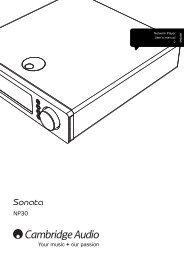
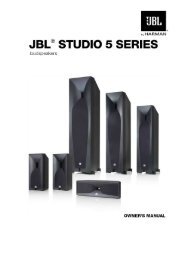

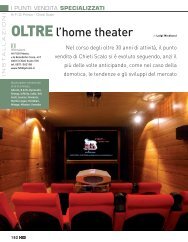
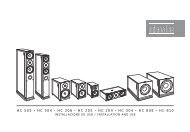


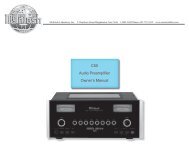
![Product Brochure [pdf] - Audio Classics](https://img.yumpu.com/22280099/1/190x245/product-brochure-pdf-audio-classics.jpg?quality=85)
